The agenda for Team Modi 3.0
When Narendra Modi entered the hallowed precincts of South Block on June 10, officials who had worked with him in the Prime Minister's Office lined the corridor and greeted him with applause. Modi walked straight to his spartan corner office and the first document he signed was an order authorising the release of the 17th instalment of PM Kisan Samman Nidhi to distribute Rs 2,000 each to the 93 million farmers in the country, an expense of Rs 20,000 crore for the exchequer. For Modi, this was all familiar territoryâhe has been here, done this for the past 10 years, over two terms. But there is a clear difference this time. Unlike the previous stints, he is heading a coalition government in his third term, Election 2024 having thrown up a verdict that saw the Bharatiya Janata Party (BJP) surprisingly falling short of a simple majority of 272 seats in the 543-member Lok Sabha. The party won 240 seats, 32 short of the required halfway mark. That has left it dependent on its 24 National Democratic Alliance (NDA) partners, who won 53 seats, to run the government.
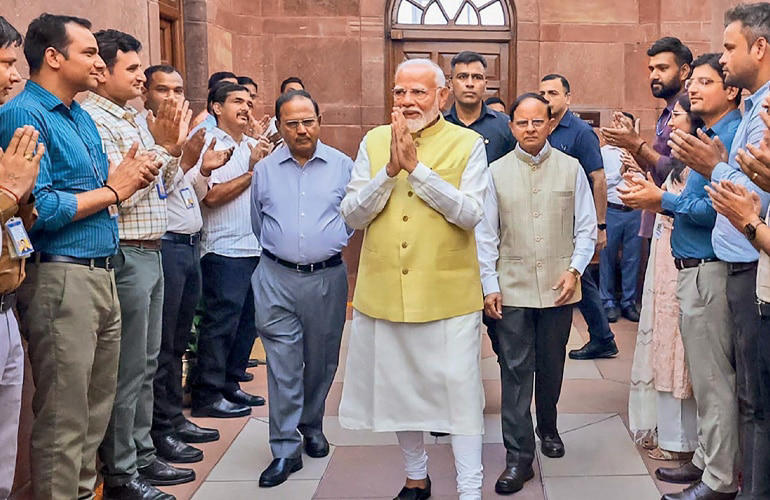
A warm welcome for PM Modi as he arrives at the PMO on Day 1 of Term 3.0, Jun. 10
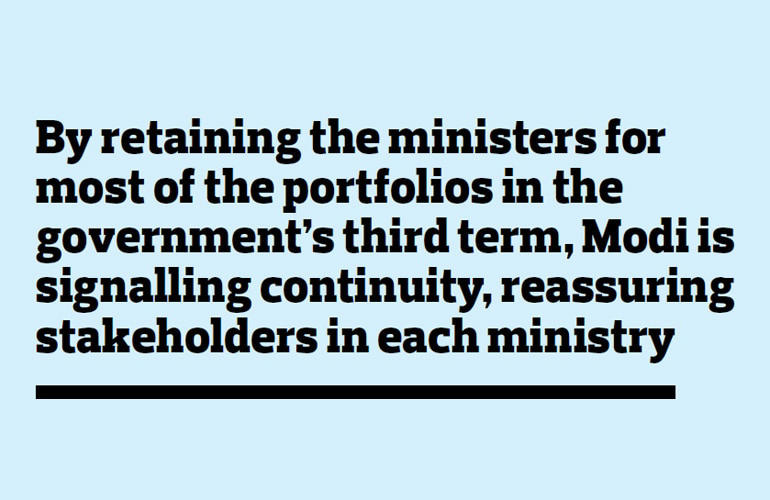
This brings its own set of compulsions, contradictions and possible conflicts that Modi will have to weather. It will certainly not be smooth sailing given that he has so far headed majority governments, be it his long innings as Gujarat chief minister between 2001 and 2014 or as prime minister from 2014 to 2024. But Modi was quick to dispel the notion that he has no experience in tackling coalition politics. He told close aides that his first major experience of handling ideologically diverse parties was during the Emergency when, as a young RSS pracharak, he coordinated with major Opposition leaders such as Morarji Desai, George Fernandes, Nanaji Deshmukh of the RSS and even Jamaat-e-Islami leaders who were a part of the underground movement to protest its imposition. He reportedly acquitted himself well.
Later, when the Congress ruled Gujarat in the 1990s, Modi, as an organisation leader of the state BJP that was in the Opposition, was the point person for the ruling dispensation to reach out to and hammer out a consensus on contentious issues. Then, in the late '90s, when Atal Bihari Vajpayee became prime minister for the second time, Modi, as BJP's organisational general secretary, played a key role in coordinating with allies, including Nitish Kumar, Sharad Yadav, Jayalalithaa and Mamata Banerjee. Citing this to demonstrate that he is no novice in matters of coalition politics, Modi will use the experience to handle the nitty-gritty of running a coalition government.
Message in the Modi Cabinet
While forming his cabinet, Modi set the tone and tenor of the new NDA government, with the BJP retaining all the heavyweight portfolios, such as finance, defence, home, foreign affairs and commerce, accounting in all for 85 per cent of the total. The message was unambiguous: Modi and the BJP may not have a majority on their own, but he will run the government pretty much how he wants to. By keeping the ministers unchanged in these portfolios, Modi has signalled continuity in policy that should be reassuring to all the stakeholders in each of these ministries. His 72-strong ministry comes with vast experience, including as it does six former state chief ministers and 43 ministers who have served three or more terms in Parliament (see accompanying graphic, The Modi Sarkar). There is plenty of fresh blood and new energy too, with 26 of the inductees never having held a ministerial post before. The prime minister's new cabinet is also very inclusive, in that 24 of the 28 states are represented. Nine NDA partners have been assigned 11 portfolios, with the largest of themâthe Telugu Desam Party (TDP), which won 16 seats, and the Janata Dal (United) or JD(U), which got 12âgetting two ministries each. In terms of the overall caste break-up, more than 60 per cent belong to the underprivileged classesâ27 of them from the Other Backward Classes (OBCs), 10 from the Scheduled Castes, five from the Scheduled Tribes and five from among the minorities, but no Muslim.
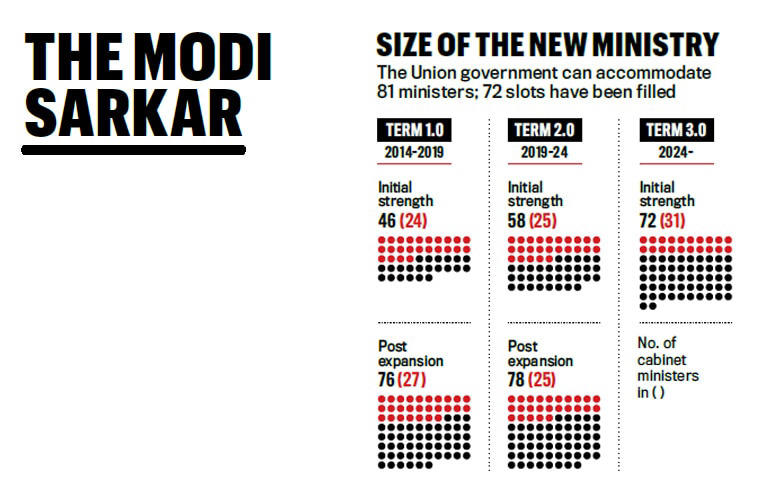
(Text: Kaushik Deka; Graphic: Tanmoy Chakraborty)
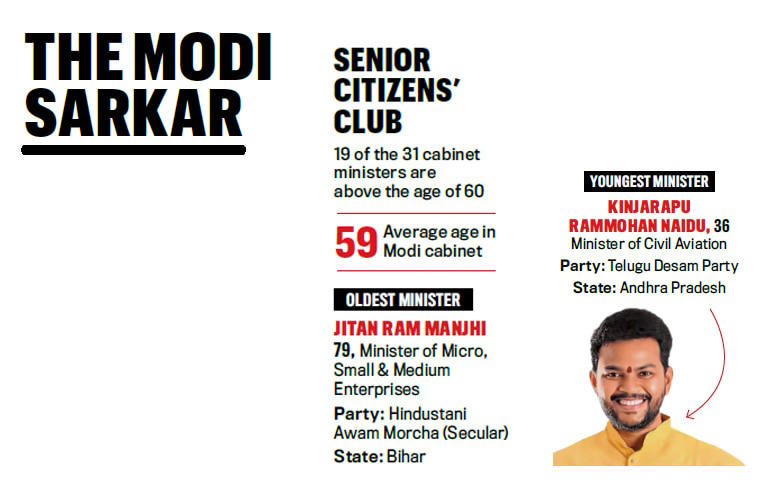
(Text: Kaushik Deka; Graphic: Tanmoy Chakraborty)
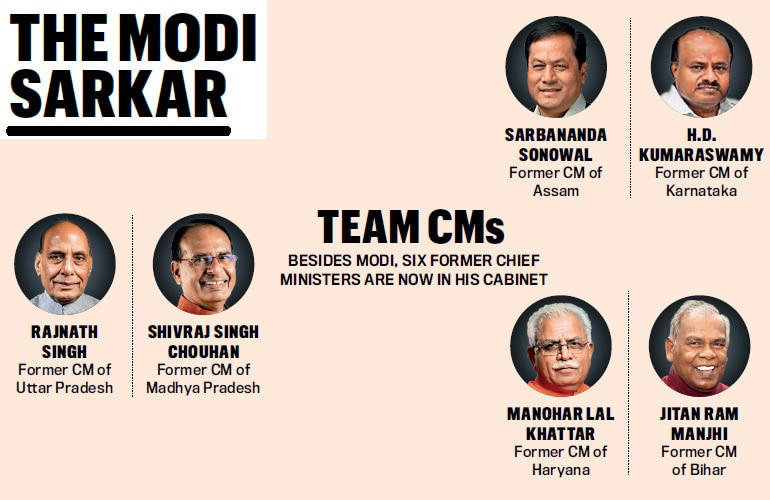
(Text: Kaushik Deka; Graphic: Tanmoy Chakraborty)
Modi and the BJP came in for some unexpected ticking-off by RSS (Rashtriya Swayamsevak Sangh) sarsanghchalak Mohan Bhagwat in a speech from the organisation's Nagpur headquarters on June 10. Expressing displeasure at the divisive discourse among political parties during the election, Bhagwat said, "The manner in which events have unfolded, with each side engaging in below-the-belt attacks, ignoring the divisive impact of campaign strategies and increasing social and mental fault lines, is concerning." He advised the new government to work on building a national consensus and not treat the Opposition as enemies of the state. Bhagwat indicated that he was unhappy with the Modi government's handling of the continuing crisis in Manipur. But it was Bhagwat's remark that a "true sevak" is one who does his task without taking pride in the accomplishment and is free of arrogance that hit home. The next day, Modi via his X handle, told all his supporters to remove the suffix "Modi ka parivar" from their handles, which they had been requested to add during the election. Soon after, there was a call for a review meeting of the BJP-RSS brass to ensure a greater coordination of purpose that had gone missing during Election 2024.
Now for the hard part
The real test for Modi, though, will be his ability to successfully overcome the various challenges that confront him in his third term. Chief among them is the state of the economy, which is being held as the primary reason for the BJP's underwhelming performance at the hustings. Despite India being among the world's fastest-growing large economies, clocking a GDP growth of above eight per cent, pre- as well as post-poll surveys have indicated that people were the most unhappy with the Modi government over two key issuesâunemployment and inflation. Also, that India's young and aspirational millions, who constitute a majority of the working population, were no longer satisfied with doles but wanted to earn a decent living instead. Their version of the Great Indian Dream included being gainfully employed, having a concrete roof of their own over their heads, enough food to eat, potable water to drink, bathrooms in their houses, quality schools for their children, healthcare for their families and connectivityâin terms of both transport and communications. Ease of living, and not just being above the poverty line, was the new minimum. Modi's call for a Viksit Bharat (Developed India) by 2047 was a distant dream, citizens wanted a Sukhi and Surakshit Bharat (happy and secure) in the next five years and expected the Modi government to keep pace with their growing aspirations.
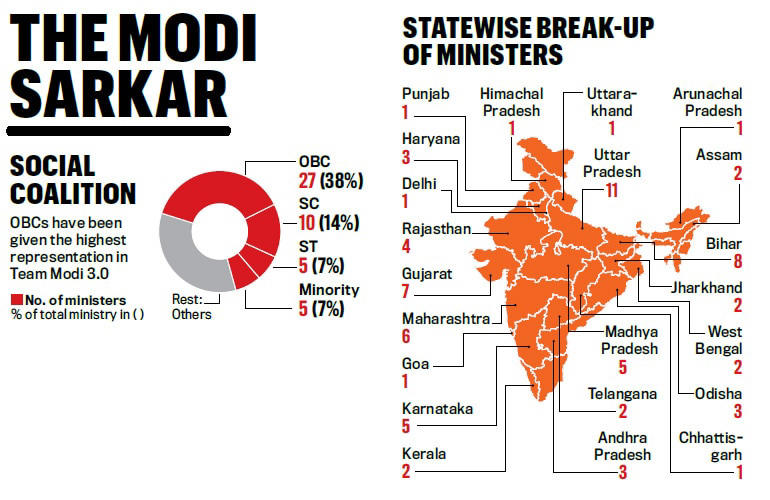
(Text: Kaushik Deka; Graphic: Tanmoy Chakraborty)
To his credit, Modi has in his preceding two terms ensured that the basic needs of most Indians, be it food, drinking water, sanitation and, to some extent, housing, were met, though there is immense scope for improvement in last-mile delivery. He has also introduced several far-reaching economic reforms such as the Goods & Services Tax (GST) and the Insolvency and Bankruptcy Code, which has helped clean up the non-performing assets of banks. He also drastically cut back corporate tax rates to stimulate private investment and spent massive sums of public money to build infrastructure. His prudent handling of the economy during and after the pandemic came in for universal praise. At the political level, the abrogation of Article 370, the construction of the Ram temple in Ayodhya in addition to the partial implementation of the Uniform Civil Code with the criminalisation of triple talaq has brought a sense of closure, however controversial, to many of these vexatious issues.
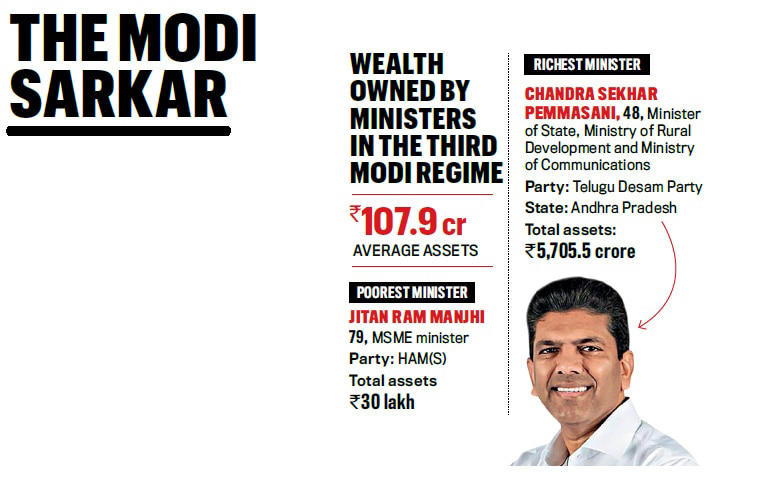
(Text: Kaushik Deka; Graphic: Tanmoy Chakraborty)
That said, his decade-long tenure has had its fair share of setbacks. His attempt to reform agriculture met with strong farmers' opposition, forcing him to repeal the farm laws, land reforms remained a stillborn project, while his government's inability to boost the share of manufacturing beyond 17 per cent of the GDP remains a blot, with small scale industry still gasping for survival, and growth in exports flattering to deceive. Inexplicably, two major job-creating sectorsâtourism and textilesâremain neglected treasures. Most PSU disinvestment plans have been postponed indefinitely. Education reform and skill development have proceeded at a leisurely pace while initiatives in health need to go beyond providing insurance and subsidised medicine and focus on a qualitative shift in treatment and facilities.
The low-hanging fruit
Having chalked out a 125-day agenda long before the election was over, Modi and his team are likely to hit the ground running. The first indication of what the new government intends to do to stimulate the economy should come with the full Union budget in July. With 44 per cent of India's labour force in agriculture and accounting for only 15 per cent of the total GDP, improving labour productivity in this sector is an urgent imperative. With another massive chunk of labour employed in the small-scale sector, which has yet to recover from the blows of the pandemic, the country's unemployment and underemployment situation remains precarious. As a top economist who did not wish to be named says, "The fundamental problem is that capital is concentrated in places where there are fewer workers. And a large part of the workforce is working without capital. All these account for low labour productivity. Ultimately, it is a transformation problem. More workers have to be brought into manufacturing and services. The false binary between manufacturing and services must go and we should walk on both these legs."
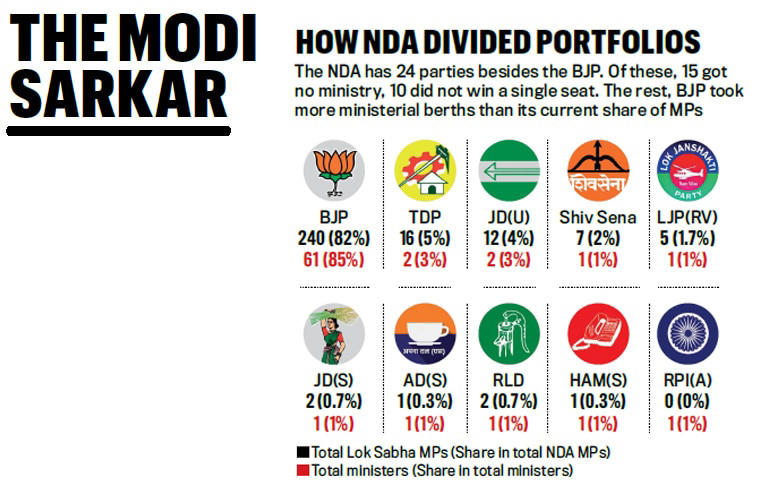
(Text: Kaushik Deka; Graphic: Tanmoy Chakraborty)
In agriculture, the government should find ways to wean farmers away from their debilitating addiction to grain production and diversify into the higher-paying though risky business of horticulture while meeting the country's requirement for pulses and edible oils, which we continue to import in large quantities. Almost one third of agricultural produce is estimated to go to waste due to poor post-harvesting techniques and insufficient primary processing and storage infrastructure. India's Rs 2.5 lakh crore processed food industry continues to be at a nascent stage, accounting for 1.8 per cent of the GDP currently but with the scope for exponential growth. The 2020 farm laws passed by the Modi regime during the Covid pandemic were meant to break the logjam in the sector, but the manner in which they were rammed through didn't inspire confidence among farmers, particularly in the country's grain bowl of Punjab, Haryana and parts of Uttar Pradesh. The government must now address their key fearsâand needs. It could set up a network of cold chains to preserve fruits and vegetables, besides incentivising farmer-producer cooperatives that could enable them to transport and sell their produce at remunerative prices.
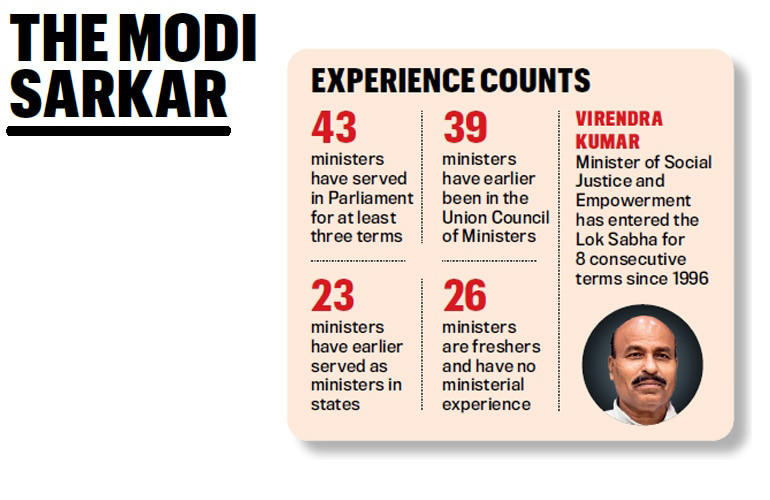
(Text: Kaushik Deka; Graphic: Tanmoy Chakraborty)
Experts say that apart from agriculture reform, there are several low-hanging fruit that the Modi government can pluck. For instance, the tangled multiplicity and maze of Indian labour laws has been a chief constraint in private sector growth. Modi had in his second term talked about lowering India's "regulatory cholesterol" and, among other things, got his government to subsume the 29 central and industrial labour laws into four new labour codes. These codes covered social security; occupational safety, health and working conditions; industrial relations; and wages. The bill was passed in September 2020 and draft central rules issued. Twenty-four states, barring West Bengal, Sikkim, Meghalaya and Nagaland, have published their draft rules since. All that is left is for the Centre to issue a final notification to make the rules come into effect, but it will first have to overcome the massive pushback from labour unions across the country. Simultaneously, the country's skill development programme must be beefed up forthwith to meet the drastic shortfall of skilled manpower in the country. Also, to kickstart reforms in the labour-intensive textiles and tourism sectors and put them on the fast track.
Unleashing animal spirits
The government will have to work on two other major factors of productionâland and capitalâto unleash the animal spirits of entrepreneurship and trigger a surge in private investment. In his first term, the Modi government yielded to farmers' protests and backed down from implementing the controversial land acquisition bill that had made it easier to convert agricultural land for use in industry and infrastructure projects. Experts say that the land market in urban India is among the most expensive in the world, largely because of the scarcity. It whittles down the competitive advantage of Indian enterprises when it comes to setting up large factories requiring vast tracts of land. One option is to begin freeing up the enormous acreage owned by the government either through public sector units, the defence forces, particularly the cantonments, or the railways. Easing of floor space index restrictions could also permit the vertical growth of cities.
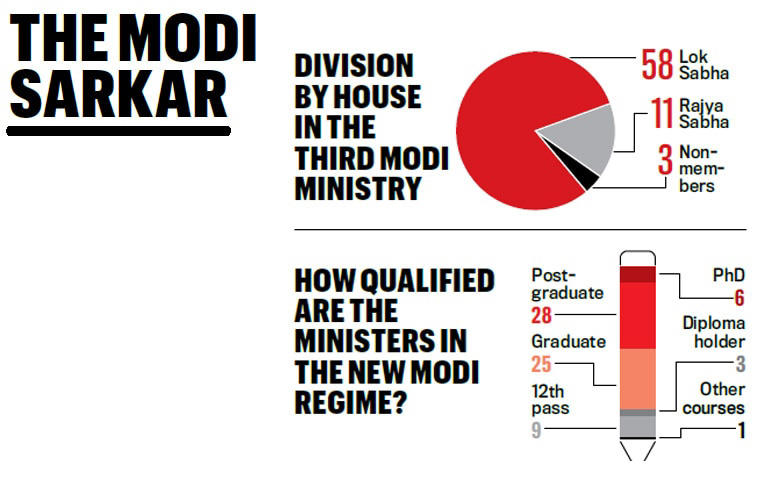
(Text: Kaushik Deka; Graphic: Tanmoy Chakraborty)
Meanwhile, in the finance sector, the process and procedure of securing finance, the lifeblood of the economy, are still cumbersome and could do with reform on priority. A majority of the 12 public sector banks remain inefficient disbursers of capital, forcing the government to step in and wipe out their NPAs with an infusion of Rs 2.46 lakh crore in 2019. Despite this, PSU bank NPAs stood at Rs 3.7 lakh crore in October 2023. While most PSU banks need to be privatised, the NBFC (non-banking financial company) sector must be encouraged to flourish. The other worrying factor is that with sluggish global economic growth, fresh investment plans by the Indian private sector fell 15.3 per cent in 2023-24 from a high of Rs 37 lakh crore the previous year, while foreign investors slashed new outlays by a third in the same period. To stimulate private investments and prevent further FDI flight, there is a call to ease the regulatory regime across the board, as investors complain of being treated as though they are guilty and have to prove their innocence.
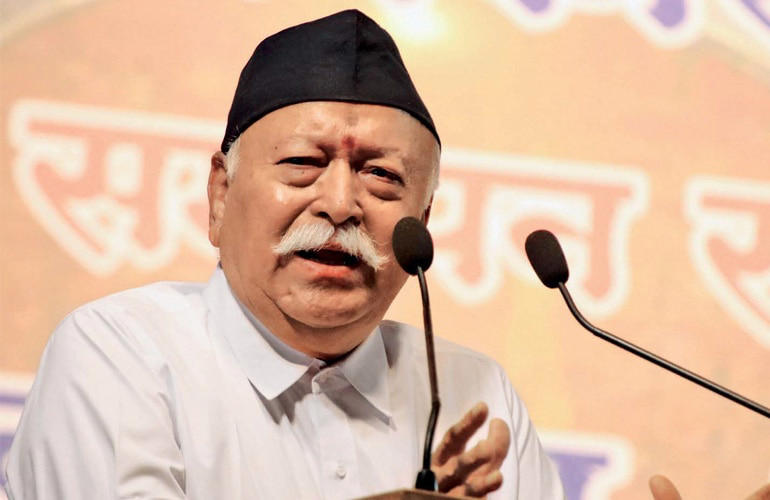

The power of investigating agencies such as the Enforcement Directorate and the Directorate of Revenue Intelligence to arrest and jail people, besides confiscating their assets, has acted as a dampener. Especially as the Modi government has not shied away from using these agencies to settle scores with their political opponents. The other critical reform is rationalising the GST to two slabs from the current four and making it easier for small traders and entrepreneurs to file their bills. Reducing the level of income tax for the middle class in line with the reduction of corporate tax could spur consumption too.
The new federal pact
The exports sector, meanwhile, could do with immediate attention, as growth of merchandise exports plateaued at $437 billion (Rs 36.5 lakh crore) in 2023-24. The intention to sign more bilateral free trade agreements is a welcome one, but the process has to be speeded up. Boosting trade with India's neighbours could dovetail neatly into India's broader foreign policy agenda. After Pakistan thwarted the growth of the South Asian Association for Regional Cooperation (SAARC), India set up the Bay of Bengal Initiative for Multi-Sectoral Technical and Economic Cooperation (BIMSTEC) that has Bangladesh, Bhutan, Nepal, India, Myanmar, Sri Lanka and Thailand as its members. The grouping was set up in 1997, but only five summit meetings have been held in the past 27 years, the last one in March 2022. As a foreign policy expert puts it, "If India has to become a great power, it must first become a major regional one. We must focus on expanding regional trade as China did with ASEAN and Central Asia even as it expanded its footprint across the world."
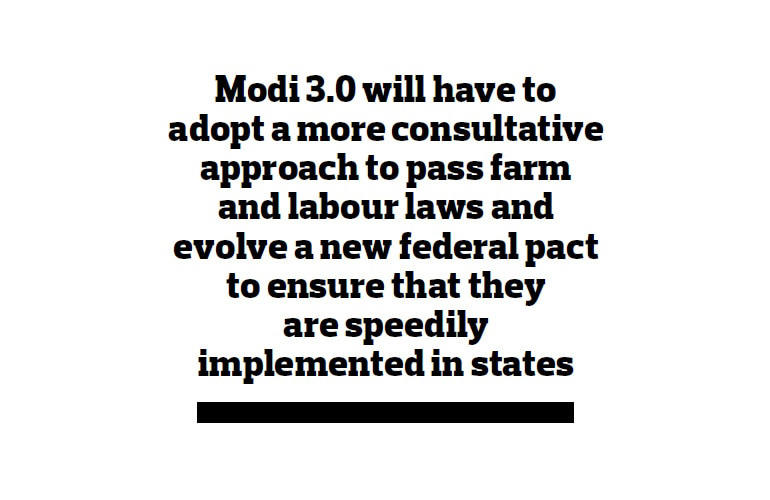
Critical to the success of Modi's third tenure will be evolving a new federal pact to ensure faster growth, speedier implementation of reforms and service delivery to the last mile and last house in rural areas. The Union government must also stop the practice of introducing multiple central cesses to avoid revenue-sharing with states. Modi talks proudly of the fact that the BJP is in power in some way or the other in as many as 18 of India's 28 states, something that should make his task of building a consensus much easier. Many experts point to the need for micro-reforms at the state, district and panchayati raj levels to ease administrative hurdles and encourage entrepreneurship and innovation at the grassroots level.
While Narendra Modi has said enough on encouraging competitive as well as cooperative federalism, he must work on a less confrontational approach than the one that the Centre has hitherto exhibited. One example is the way governors have routinely overstepped their powers in Opposition-ruled states. Modi and the BJP must also scrupulously observe the coalition dharma if the NDA government has to survive. Plus, as RSS chief Bhagwat has advised, the need of the hour is national consensus. Modi's dictum of 'Reform, Perform and Transform' remains relevant. If he and his team are able to achieve all that we have listed in the following pages as agendas for the various ministries, Modi 3.0 will emerge as a game-changer in India's march towards Viksit Bharat.
Watch Live TV in English
Watch Live TV in Hindi
